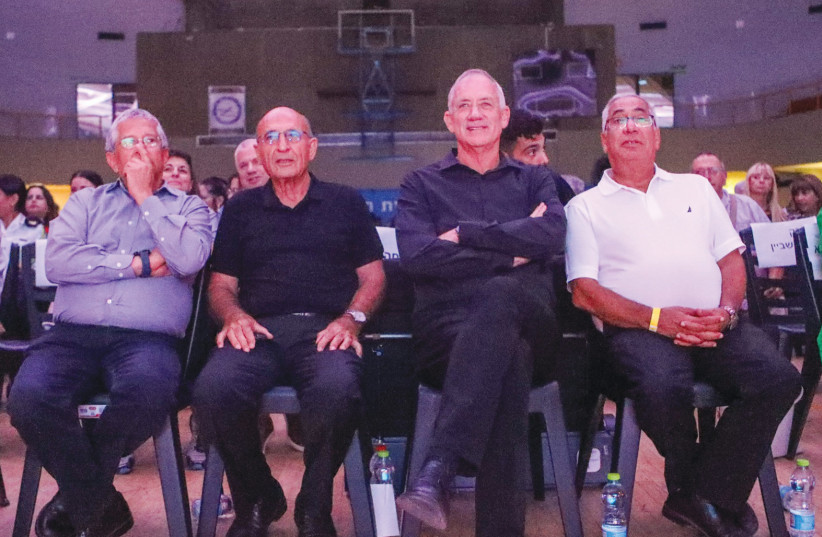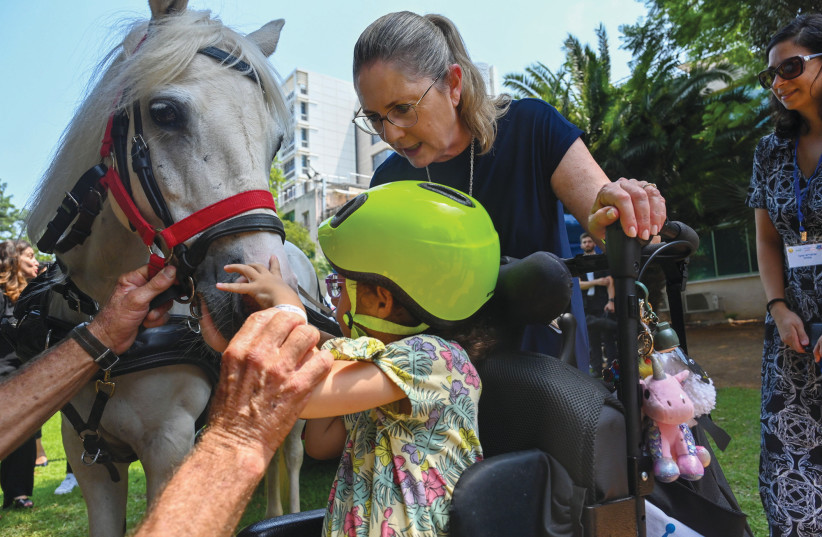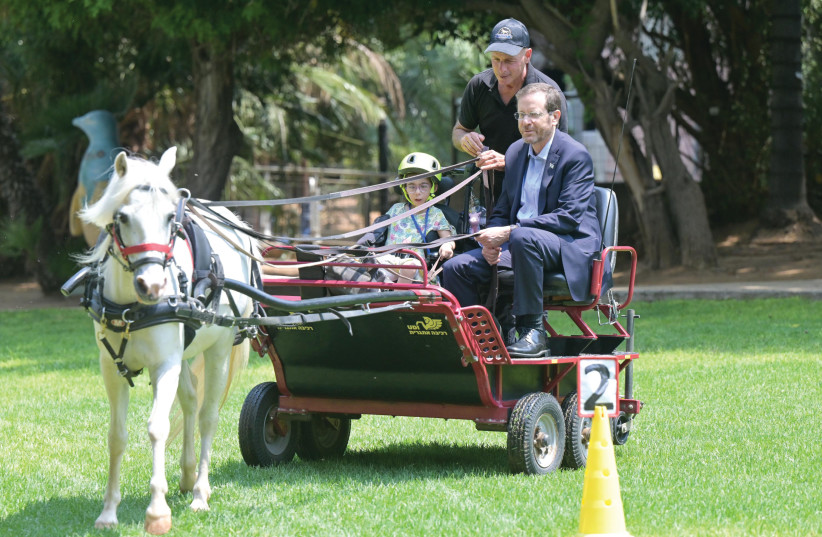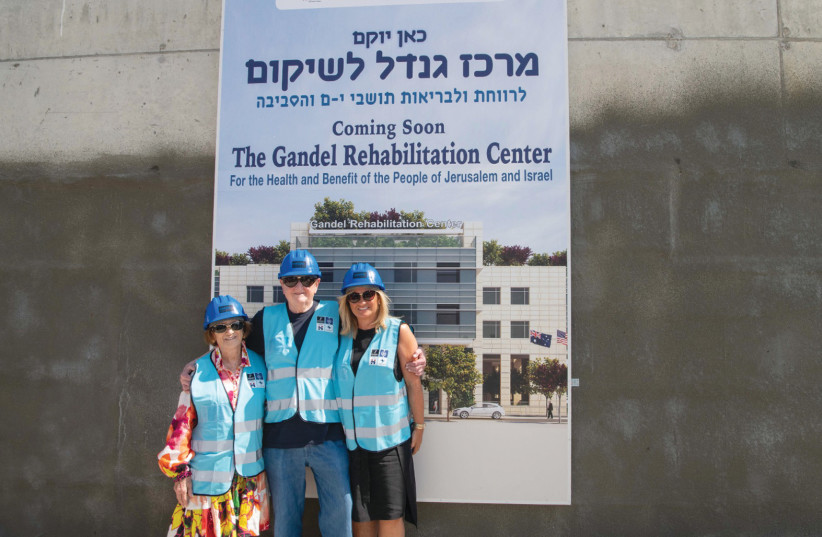There are no real winners in a war. There are casualties and injuries on both sides, and even when one side gains the upper hand, it is never without bloodshed, without human sacrifice.
Contrary to Palestinian and international reports, the head of Israel’s Public Diplomacy Directorate issued a statement of clarification declaring that Islamic Jihad was responsible for the killing of children in Jabalya. This and other statements regarding the deaths of innocent Gazans at the hands of Islamic Jihad have already been published, and in some cases accompanied by video evidence.
The videos offer irrefutable proof that the first of these tragic incidents was the result of the misfiring of a rocket launched from within the Gaza Strip which fell in the heart of Jabalya. All fire by the Islamic Jihad terrorist organization is a double war crime, the statements continue. It is shooting at civilians, and using Gazan civilians as human shields.
In various interviews, Israeli army officials and officers have underscored that every effort is being made to avoid harming innocent civilians.
Nonetheless, regardless of provocations, it is only natural for the Arab population and for non-Arab Israeli pacifists to condemn any Israeli strike against Gaza, just as it is natural for Diaspora Jews to condemn any strike from Gaza into Israel.
In reporting armed conflicts, it is difficult for journalists from either side to remain objective. Israeli journalists, for instance, often refer to “our forces” instead of saying “Israeli forces.”
Sometimes this lack of objectivity goes far beyond that. On KAN Reshet Bet, Liat Regev, in an interview with Joint List MK Aida Touma-Sliman, became near hysterical as Touma-Sliman explained her reason for joining in a protest demonstration against Operation Breaking Dawn. Regev completely lost her cool and began screaming at her interviewee, who remained calm and self-controlled, and asked whether Regev intended to continue in this vein or whether she was prepared to listen to the answers to the questions that she asked.
Breaking Dawn's silver lining
■ EVERY CLOUD has a silver lining, and in the case of Operation Breaking Dawn, heads and residents of southern regional councils who had targeted Prime Minister Yair Lapid and Defense Minister Benny Gantz for bitter criticism came full circle and began to praise them and thank them.
People who are suffering often fail to realize that timing and having the right bargaining chip are everything.
Moreover, those who think that the government and the army are not doing enough to ensure the security of citizens, or working to bring home those in enemy captivity, are usually mistaken. Operation Breaking Dawn had been planned well ahead of what happened over the past weekend.
Additionally, while there is general sympathy for, and empathy with, the families of soldiers Hadar Goldin and Oron Shaul, who are believed to have paid the supreme sacrifice in Operation Protective Edge in 2014, and whose remains are still in Gaza, and the families of civilians Avera Mengistu and Hisham al-Sayad, who are in captivity in Gaza, to keep on publicly accusing the government and the army of doing nothing serves no purpose other than to play into the hands of the enemy. Would any of these four families want to have a prisoner exchange in which 1,000 Palestinian security prisoners are released in exchange for their loved ones? Such disproportionate deals have been made in the past to Israel’s detriment.
During World War II, the slogan “Loose Lips Sink Ships” was widely used on US Army posters. That message is still valid today. The more the government is publicly criticized for doing nothing with regard to the return of Israeli prisoners, the more the Gazans will up the ante.
Painful though it is to wait for so long to see the light at the end of the tunnel, it was no less painful for the families of Hezi Shai, Ehud Goldwasser and Eldad Regev, Gilad Schalit, Eliyahu Abutbul, Danny Gilboa, Rafael Hazan, Reuven Cohen, Avraham Mindvelsky and Avraham Kronenfeld, Yosef Fink and Rahamim Alsheich, and many others. More often, remains were returned rather than live PoWs. But the Israeli authorities, regardless of which government was in power, did not give up, and the price was often outrageously high.
The remains of Zechariah Baumel, who was reported missing in action following the Battle of Sultan Yacoub in the First Lebanon War (1982), were returned to Israel in 2019, only due to intervention by Russian President Vladimir Putin.
Tribute to disabled naval vets
■ AFTER YEARS of fighting to be recognized as disabled veterans, members of IDF naval units who, during training sessions, swam for more than 30 days in the polluted Kishon River near Haifa and became seriously ill, finally won their battle half a year ago.
The Defense Ministry’s decision last February to recognize these veterans came on the recommendations of an expert committee led by Brig.-Gen. (ret.) Ran Bashvitz, in coordination with the IDF Disabled Veterans Organization, and approved by Defense Minister Gantz. Previous committees over the years had not found the connection between the Kishon and the illnesses of the veterans; but with the aid of new medical technologies, it was possible to prove that there was indeed a strong connection.

Last week, Gantz attended a tribute event honoring the men who had swum in the Kishon. Also present were former defense minister and chief of staff Shaul Mofaz, chairman of the Israel Paralympics Committee Eli Birnbaum, and David Luria, the chairman of the Kishon Disabled Veterans and the leading figure in the fight for them to be recognized as such. At the event at Beit Halochem, citations were given to Gantz, Defense Ministry Director-General Amir Eshel, and head of the IDF Rehabilitation Department Limor Luria.
Idan Kleiman, the outgoing chairman of the Disabled Veterans, thanked Gantz for taking the courageous step on their behalf. Kleiman also thanked Mofaz, who took the initial step in that direction. Kleiman did not forget to thank spouses and other family members for their ongoing support for the veterans.
Herzogs visit the hospital
■ COINCIDENTALLY, ON the same day, President Isaac Herzog and his wife, Michal, who are longtime supporters of Beit Loewenstein rehabilitation hospital, which is one of the largest Israeli hospitals in the field of rehabilitation medicine, paid a visit and met with patients and staff. They were also given a briefing on new technologies and equipment that are being used in various therapies.


Beit Loewenstein is affiliated with Clalit Health Services, so it was natural for Clalit chairman of the board of directors Yohanan Locker to join Beit Loewenstein CEO Dr. Hagay Amir in welcoming the Herzogs.
Avi Luftan, 42, from Kiryat Shmona, told the Herzogs that he is a disabled army veteran. Twenty years ago, he was seriously injured during his military service, and for nearly two decades he suffered excruciating, chronic pain. Physicians advised him to undergo the amputation of his leg. It was a difficult decision for him to make. But in consultation with various medical professionals, he reached the conclusion that this was the best course for him.
What helped him a lot, he said, were the interpersonal relationships with his nurses, his therapist and even the head doctor. They were with him all the way, as were other patients, he said. The nurses let him know they cared, because they frequently checked on him. The door of his physician Dr. Michael Tamir was always open to him. “I feel as if he’s my support system, and that’s very important,” said Luftan. “He gives me the strength to continue to develop.”
The Herzogs were charmed by a cute five-year-old girl who happens to have been born a spastic. Among the therapies prescribed for her are pony rides and petting. Michal Herzog joined the little girl in petting the pony, but the president was braver, and got into a pony-drawn cart with her, and the two – the president and the little girl – went for a ride together.
New rehab center down south
■ ACCORDING TO Health Minister Nitzan Horowitz, there is an acute shortage of rehabilitation centers around the country. One has recently been opened in the southern region, and another will soon be opened in the North, but none will be as large, diverse and cutting-edge as the new Gandel Rehabilitation Center for the Health and Benefit of the People of Jerusalem and Israel, which is due to be completed next year, and will open at Hadassah-University Medical Center, on Jerusalem’s Mount Scopus.
Made possible by the Gandel Foundation headed by John and Pauline Gandel of Melbourne, Australia, it was officially named this week in the presence of Australian Ambassador Paul Griffiths, Horowitz, Hadassah Medical Organization Director-General Prof. Yoram Weiss, Dalia Itzik, chairwoman of the HMO Board of Directors, MK Idit Silman, chairwoman of the Knesset Health Committee, Rhoda Smolow, president of Hadassah, the Women’s Zionist Organization of America, Jorge Denier, executive director of Hadassah International, many Hadassah board members and hospital management staff, and Paul Israel, executive director of the Israel-Australia Chamber of Commerce.
Donning hard hats and distinctive blue vests, John and Pauline Gandel, accompanied by some of their family, arrived to inspect the building, which is in the process of construction. Despite being octogenarians, they climbed stairs, listened, while standing, to long explanations, walked across concrete flooring, which will be covered when they return next year, but were also taken to a completed showcase room for two patients, with lots of natural light, a huge window offering a panoramic view, parquet floor, large television screen, built-in closet, and a queen-size bathroom with both overhead and hand showers, but more important a doorway wide enough for a wheelchair to get through with ease.
Proof of what Hadassah has already done in terms of rehabilitation came with the arrival of two young soldiers who had been seriously injured during training exercises, and who had not had much hope of survival, let alone leading normal lives if they did survive. Not only were they saved, but they were restored to health and returned to army service.
The Gandel gift is one of the largest ever received by Hadassah beyond the United States. American donors, who are in the vast majority, as attested by the many plaques all over the Hadassah campuses, have been exceedingly generous, but the Gandels have set a new standard for people outside America.
Aside from the fact that the rehabilitation center will help people of all ages and backgrounds to recover from every kind of injury, illness or disease and regain their independence, the building is designed in such a way that it can be easily expanded outward and upward, if and when the need arises.

Following the official building naming ceremony and the unveiling of the plaque that extols the Gandels’ passion, commitment and dedication, there was a spontaneous rendition of “Me’al Pisgat Har Hatzofim” (From the summit of Mount Scopus), followed by “Jerusalem of Gold.”
Everyone then proceeded to Hadassah-University Medical Center in Jerusalem’s Ein Kerem, where the Gandels had never been before, but were very impressed with what they saw. They then came to a celebratory luncheon, at which the Hadassah fare could easily compete with anything served at the buffet of a five-star hotel. They were joined at the luncheon by Jerusalem Mayor Moshe Lion, Yad Vashem chairman Dani Dayan and hospital department heads and other senior staff.
Every speaker, both on Mount Scopus and in Ein Kerem, emphasized the importance of the new facility, the number of people it would serve, and how many people would not have to travel vast distances to other already existing rehabilitation centers.
Even then, the problem of curing the sick and the injured will not be solved. There is a dire need for more hospitals and rehabilitation centers, said Horowitz, who was pleased that the Gandel gift will greatly relieve the burden.
Smolow noted that the new building stands where Henrietta Szold, the founder of Hadassah, had her vision almost a century ago. Szold laid the cornerstone for Hadassah Hospital on Mount Scopus in October 1934. She founded Hadassah in 1912. Of the Gandels, Smolow said: “They’re not just donors. They’re warm, loving people.”
Indeed, with their casual, hail-fellow-well-met, typically Australian attitudes, the Gandels had chatted with everyone and anyone, had shaken countless hands and patted people on the arm or the shoulder.
Saying that they had made “a tremendous contribution to the heart of the Jewish people,” Lion thanked the Gandels on behalf of all the residents of Jerusalem, adding: “You are here helping us to keep that heart beating and strong.” He also underscored that the Gandel Rehabilitation Center would provide the best medical services in the country. Although Hadassah is one of the oldest hospitals, he said, “it is a symbol of innovation.”
John Gandel said that everybody, at some stage in their life, gets a little revelation. His had come the previous evening, he said, when having dinner with Itzik and Smolow. He had discovered that he had more than one mother. He had always believed that his own mother, who came to Australia from Poland in 1928, was his only mother, but Itzik and Smolow had informed him that he had 300,000 mothers who were members of Hadassah.
He and his wife see their support for Israel as a duty and an obligation, he said, but the guideline in all their giving to both Jewish and non-Jewish causes in Australia and Israel is to improve the quality of life for others.
At the same time, he stressed, he and his wife are not unique. The Jewish community of Australia is a strong advocate, supporter and defender of the State of Israel, he said.
Hadassah's 100th national convention
■ MANY OF the people who were gathered on Mount Scopus and in Ein Kerem this week will come together again in November for Hadassah’s 100th national convention, which will take place in Jerusalem on November 14-17 to celebrate more than a century of empowering women to help to heal.
During the convention, participants will honor Marlene Post, former president of Hadassah and of Hadassah International, for all that she has done for Hadassah, Israel and the Jewish people.
Organizations in which she has served, mostly as president, chairwoman or board member, include Birthright Israel North America, the Confederation of United Zionists, Israel Bonds, the advisory council of the New York Board of Rabbis, the Jewish Community Relations Council of New York, and United Jewish Appeal-Federation of New York. A nurse by profession, she has also been a long-standing member of the Jewish Agency’s board of governors, which she joined in 1998. She has also been active in other organizations and institutions.
125 years since the First Zionist Congress
■ WELL AHEAD of the Hadassah convention is the 125th anniversary of the First Zionist Congress, which will give a boost to Basel rather than Jerusalem, as participants will be coming from all over the Jewish world. So far, more than 90 speakers are listed for the two-day event, which will be held on Sunday and Monday, August 28 and 29.
Following the First Zionist Congress on August 29, 1897, Zionist visionary Theodor Herzl wrote in his diary that on that day he had founded a Jewish state. Fifty years later, on November, 29, 1947, a vote by the General Assembly of the United Nations enabled that statement to become a reality. Herzl added to the 1897 entry about founding a Jewish state: “In five years, perhaps, certainly in fifty, everyone will perceive it.”
The 125th anniversary gala has been organized by the World Zionist Organization, headed by Yaakov Hagoel, in cooperation with the Swiss Federation of Jewish Communities.
One of the highlights will be the cocktail reception at the Stadtcasino, the venue of the First Zionist Congress exactly 125 years to the day earlier. Some 1,100 guests have been invited. The multifaceted program will focus on Herzl’s vision of yesteryear, Zionism as it is today and visions of Zionism in the future.
No doubt, hundreds of photographs will be taken of people in copycat poses leaning over the balcony like Herzl in the iconic photograph taken 125 years ago.
Huldai approached by tourists
■ TEL AVIV MAYOR Ron Huldai, while going through the city on Saturday to assess the situation, was approached by English-speaking tourists who asked if he knew what was going on. “Of course I know what’s going on,” he replied. “I’m the mayor.”
Edna Halbani
■ ROSH HASHANAH is a time when many Jewish publications put out a list of the 50 or 100 most influential Jews. Many publications are currently looking at names that have been recommended, and when their lists are published, many of their readers will find more thumbnail biographies of people they’ve never heard of, than of people whose names are familiar to them because they are frequently mentioned in the news.
One name that should be included in Israeli lists is that of Edna Halbani, referred to as the chief of protocol in the Prime Minister’s Office or the coordinator of international visits in the Prime Minister’s Office. Either way, she’s an extraordinary behind-the-scenes person, though she can sometimes be seen in photographs of farewell entourages of Israeli prime ministers as they travel abroad and in the line of dignitaries on the tarmac of Ben-Gurion Airport who have come to take their leave of a visiting dignitary, as for instance during the farewell ceremony for US President Joe Biden. It was impossible to miss her, as she stood out in her red dress.
While one should never ask a lady about her age, Halbani makes no secret of the fact that she has been in the Prime Minister’s office “from Golda to Lapid” and attributes her longevity in her workplace to the fact that she was not a political appointee. She has worked with prime ministers on both the Left and the Right of the political spectrum, has organized their overseas trips and has traveled abroad with them.
Popular wisdom concedes that everyone is replaceable, but it would seem that Halbani is indispensable. One doesn’t have to be a rocket scientist to do the arithmetic that indicates that she is well past the retirement age for civil servants, but she is so knowledgeable, so efficient and so familiar with all the tiny details that go into an official visit that no one wants her to step down.
Some world leaders who have been coming to Israel since they were junior politicians know her well and look out for her when they arrive. They are also happy to welcome her when she accompanies the prime minister to their countries.
Most Israelis have never heard of her, even though she’s busy on Twitter. But is she a person of influence? You bet she is.
Fleur Hassan-Nahoum
■ AROUND HALF a year ago, Fleur Hassan-Nahoum was not sure whether she would compete for a seat in the Knesset. The deputy mayor of Jerusalem, who has chalked up a number of accomplishments in that role, said that she would aim for the Knesset only if she thought that she could somehow benefit Israel. If she wins the slot reserved for women in the Likud primaries, it will be a great loss to the Jerusalem Municipality.
On the other hand, if she makes 25th place on the Likud list, and if Benjamin Netanyahu succeeds in cobbling together a 61-member coalition, he would do well to make her the Jerusalem affairs minister.
While all the Zionist parties with female MKs have given prominent places to non-Ashkenazi women, there are institutions that have barely got used to the idea that women can do as well as, if not better than, men in just about every profession. Both the Likud and the Labor Party have fairly good records. But what happens in the Knesset does not necessarily happen in the Jewish Agency, which has never had a female or Sephardi chairman. Hassan-Nahoum is both, and although she also speaks four languages, has a law degree and is in charge of the Jerusalem Municipality’s international relations, it wasn’t good enough for the agency’s selection committee.
The Likud has a very sound base in Jerusalem, so there’s a good chance that Hassan-Nahoum will glean a lot of votes.
Up till now, the highest-ranking Sephardi or Mizrahi woman has been Dalia Itzik, the former Knesset speaker, who was the first and so far the only woman in this role. She also had a brief stint as acting president, and backed off from the election for president so as to ensure that the honor would go to Shimon Peres.
greerfc@gmail.com
